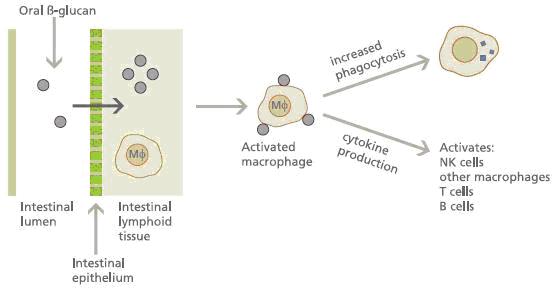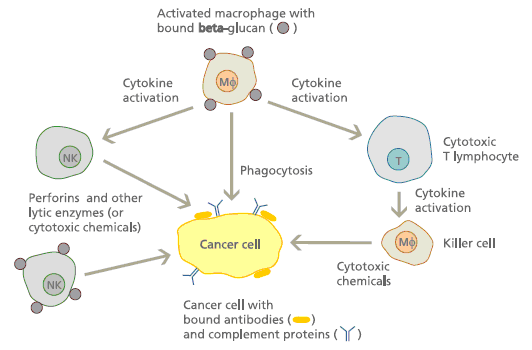
Microbial beta-glucans (principally from yeasts and fungi) have been known for a long time to stimulate the immune response, such as beta-D-glucan with (1, 3) linkages in the backbone and (1, 6) linkages as side-branches, which is called as Immunomodulator, Immuno potentiator and Biological Responses Modifier, are widely used to enhance the immunity of cancer patients and reduce the side effects of chemotherapy. Long-term research made people realize that beta-glucan is a potent stimulator of the immune system and boosts the specific immune cells, therefore release cytokine which can act as conduction signals and quickly transmit information to the corresponding immune cells. The activated immune cells stimulate the entire immune system to against alien invading by mutual coordinating and interacting thus to prevent and treat the malignant tumor and cancer. We know that cancer cells come from normal cells whose growth and death are strictly controlled by cell programme. The growth of normal cells will be out of control when problems occur, they will continue copying and start to accumulate on the surface of marrow and tissue, and then they will become tumor, otherwise, if gene mutation occurs in the accumulation process they may deteriorate into malignant tumors, viz. cancer. Although many drugs can kill tumor cells, they also kill normal cells inevitably. Therefore, to find out drugs and therapies that only specifically kill tumor cells has been the research hotspot for such a long time in cancer area. As the anti-cancer properties of beta-glucan are due to direct regulation of the immune system and have nothing side effects to normal cells, the study of glucan immune function is particularly noticeable in recent years. Attention has focused on cereal beta-glucans, which are structurally related to microbial beta-glucans, but have better solubility, making them more versatile in food formulations and therapeutic applications. Of all cereal grains, oat is the richest source of beta-glucan soluble fibre. Oat beta-glucan has been shown to significantly enhance resistance to bacterial, viral and parasitic infections [1-3] and to limit the growth of cancerous tumors [4, 5-7]. Here, we introduce the immunological function, theory and application of oat beta-glucan.
Oat beta-glucan stimulates the immune system
How does beta glucan stimulate the immune system? It is proved that beta-glucan can stimulates both innate and acquired immune responses by binding directly to macrophages and other white blood cells (neutrophils and natural killer (NK) cells) and activating them[8, 9](as shown in figure 1).

Figure 1 The immune response
Macrophages are one of the most important immune cells in the body and are understood to play a central role in beta-glucan immune enhancement. beta-glucan increases macrophages' ability to destroy invading microbes or infected cells; meanwhile it stimulates many other cells of the immune response, via a cascade of cellular interactions(figure 2).

Figure 2 beta-glucan activation of macrophages
Anti-tumor properties of oat beta-glucan
The anticancer properties of beta-glucan are due to two ways: direct stimulation of macrophages, neutrophils and NK cells and indirect stimulationvia activated macrophages of cytotoxic T lymphocytes. The relative roles of each of these cell types in beta-glucan tumoricidal activity are not fully understood, but studies indicate a primary role for macrophages.
First, tumour cells are tagged for destruction by antibodies and small serum proteins (complement proteins), which bind to the tumour cell; then, beta-glucan binds to macrophages and activates them to phagocytose tumour cells that have been tagged. This process is called opsonisation. Activated macrophages also produce cytokines that prime Natural Killer (NK) cells and T lymphocytes, both of which are cytotoxic to tumour cells, via different mechanisms. NK cells secrete chemical substances that destroy tumour cells, by bursting open cell membranes. Cytotoxic T lymphocytes secrete cytokines that stimulate macrophages to produce other tumoricidal chemical substances (Figure 3).

Figure 3 beta-glucan stimulation of antitumour immune response
Oat beta-glucan stimulation of wound healing
Macrophages play an important role in wound healing and appear to act as the key regulatory cells for skin repair. Macrophages phagocytose and destroy dead tissue, bacteria and foreign matter. Macrophages also produce growth factors that stimulate cells involved in healing (production of extracellular matrix). Oat beta-glucans have been reported to affect all phases of wound healing, increasing the rate of healing and the breaking strength of the wound. beta-glucan complexes have been shown to be practical and effective dressings for wounds and burns to give improved healing. A composite oat beta-glucan/collagen layer incorporated into a dressing gave improved healing of partial thickness burns [10-12].
The properties of Putus oat beta-glucan and its application in immunology
Although people understand the oat beta-glucan immune activity, the molecular mechanism between oat beta-glucan and immune cells especially macrophages, also the relationship between structure and activity are still unclear. The unclear conformation made people can not make the structure-based design and construct high activity polysaccharides drugs and formulations, which lead the research of polysaccharides into a bottleneck stage. Therefore, the structure-activity relationship studies in this area will become a hotspot and difficulty.
It is reported that macrophages, neutrophils (another "type" of macrophage) and NK cells have surface beta-glucan receptors, which specifically recognize and bind the (1, 3) beta linkage of the beta-glucan molecule. Two beta-glucan receptors have been described at a molecular level . Dectin-1 is the receptor mainly found on macrophages, while Complement Receptor 3 (CR3) is found predominantly on NK cells and neutrophils. In fact, it has been taken a long time to study on Dectin-1 and people set some novel programs, however, oppugn has never been stopped, which resulted in repeated experiments and stagnation. The reason is not experimental means and methods flawed, but beta-glucan sample quality can not meet the demand. The samples which scientists generally use were of very wide dispersion, or a very low purity, including a lot of different Mw dextran and other impurities. It easily brings physiological interference between polysaccharides and impurities, which impact the activity of beta-glucan, thus we could not get the desired results. Moreover, we could not determine which Mw beta-glucan plays the leading role even if we get the results.
Putus Macromolecular Sci. & Tech. Ltd. is an international corporation which has been putting effort in research, development and application of a variety of carbohydrate polymers. We are manufacturing and providing high quality carbohydrate polymer standards with unique structure and high chemical uniformity in terms of molecular weight (Mw) and degree of branching. Putus is now providing PS-OBGs, the aqueous polymer standards originated from oat bran. Our research showed that PS-OBG standard possesses a linear chain with mixed linkage of (1-3) and (1-4). There are two products suit the immunology study: PS-OBG-Vis, with three different specifications (high, medium, low) of viscosity and molecular weight, which show the purity as high as 97%; In addition, Putus provides PS-OBG-Mw, a new carbohydrate polymer molecular weight (Mw) standards with Mw ranged from 10,000 to 1,800,000 and Mw distribution (MwD) of 1.01-1.05(For more detailed molecular weight and polydispersity please consult Products Information). These non-starch, non-protein and other impurities, water-soluble, highly stable standards will undoubtedly make up the defects of current beta-glucan samples in both domestic and international research, and will provide a strong guarantee on obtaining more accurate results and more stable experimental data.
References
[1] J.M. Davis, E.A. Murphy, A.S. Brown, M.D. Carmichael, A. Ghaffar, E.P. Mayer. Effects of moderate exercise and oat beta-glucan on innate immune function and susceptibility to respiratory infection. American Journal of Physiology. 2004, 286: R366-R372
[2] A. Estrada, C. Yun, A. van Kessel, B. Li, S. Hauta, B. Laarveld. Immunomodulatory activities of oat beta-glucan in vitro and in vivo. Microbiology and Immunology. 1997, 41(12): 991-998
[3] C.H. Yun, A. Estrada, A. van Kessel, B.C. Park, B. Laarveld. Beta-Glucan, extracted from oat, enhances disease resistance against bacterial and parasitic infections. FEMS Immunology and Medical Microbiology. 2003, 35(1): 67-75
[4] N.K. Cheung, S. Modak, A. Vickers, B. Knuckles. Orally administered beta-glucans enhance anti-tumour effects of monoclonal antibodies. Cancer Immunology. 2002, 51: 557-564
[5] Hong F, Yan J, Baran JT. Mechanism by which orally administered beta-1, 3-glucans enhance the tumoricidal activity of antitumour monoclonal antibodies in murine tumour models. Journal of Immunology. 2004, 173: 797-806
[6] G.H. McIntosh. Cereal foods, fibres and the prevention of cancers. Australian Journal of Nutriton and Diet. 2001, 58:35-48
[7] E.A. Murphy, J.M. Davis, A.S. Brown, M.D. Carmichael, E.P. Mayer, A. Ghaffar. Effects of moderate exercise and oat beta-glucan on lung tumor metastases and macrophage antitumor cytotoxicity. Journal of Applied Physiology. 2004, 97(3): 955-959
[8] B.N. Gantner, R.M. Simmons, S.J. Canavera, S. Akira, D.M. Underhill. Collaborative induction of inflamm -atory responses by dectin-1 and toll-like receptor 2. The Journal of Experimental Medicine. 2003, 197: 1107-1117.
[9] J. Herre, S. Gordon, G.D. Brown. Dectin-1 and its role in the recognition of beta-glucans by macrophages. Molecular Immunology. 2004, 40(12): 869-876
[10] S.J. Delatte, J. Evans, A. Hebra, W. Adamson, H.B. Othersen, E.P. Tagge. Effectiveness of beta-glucan collagen for treatment of partial-thickness burns in children. Journal of Pediatric Surgery. 2001, 36(1): 113-118
[11] J.M. Nelson, L. Hendley Comparative study of BGC Matrix® versus Biobrane® as a skin graft harvest-site dressing. Abs 31st Annual American Burn Association Mtg., Lake Buena Vista, Florida. 1999.
[12] R. Stephens, K. Wilson, H. Meites, P. Silverstein. An evaluation of the combined therapy of EZ-Derm biosynthetic wound dressing and MacroPro oat beta-glucan wound gel with compression dressing to treat venous stasis ulcers. Journal of Burns Surgery. Wound Care 2 www.journalofburns.com. 2003

 .
.